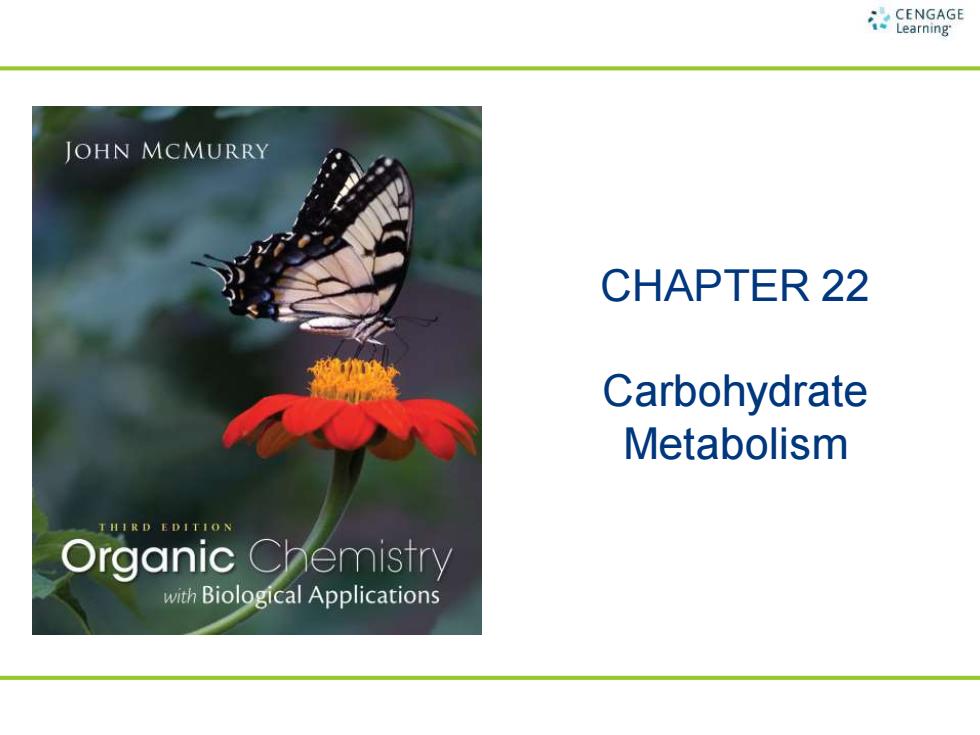
CNGNGE JOHN MCMURRY CHAPTER 22 Carbohydrate Metabolism T H IR D E DI TION Organic Chemistry with Biological applications
CHAPTER 22 Carbohydrate Metabolism
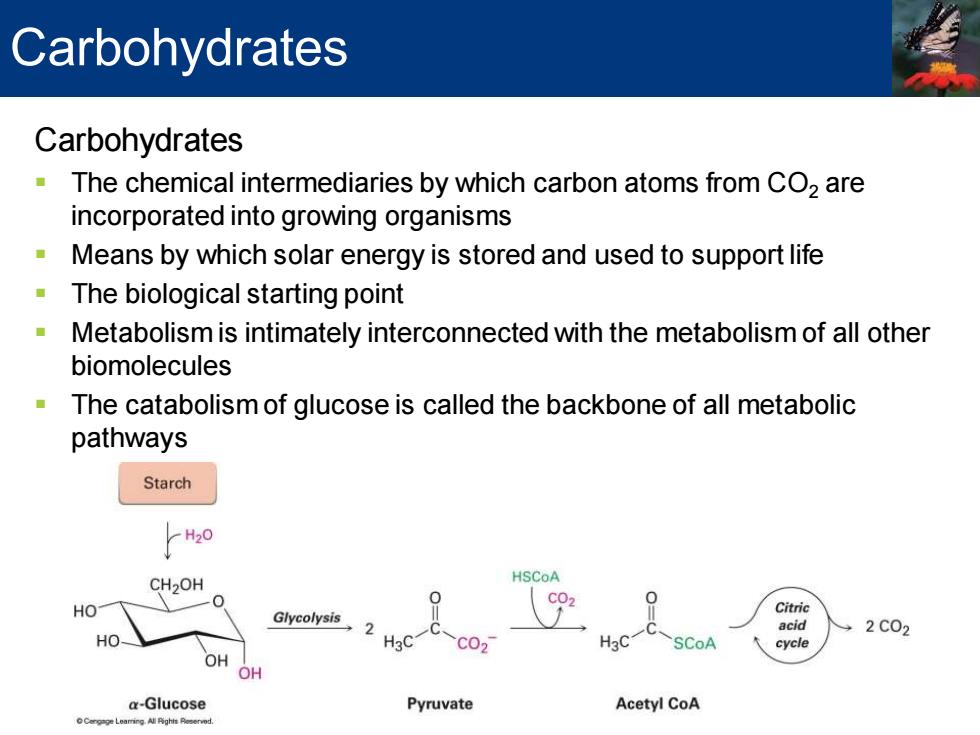
Carbohydrates Carbohydrates The chemical intermediaries by which carbon atoms from CO2 are incorporated into growing organisms Means by which solar energy is stored and used to support life The biological starting point Metabolism is intimately interconnected with the metabolism of all other biomolecules The catabolism of glucose is called the backbone of all metabolic pathways Starch H20 CH2OH HSCoA c02 HO Citric Glycolysis 2 acid →2c02 HO- H3C SCoA cycle OH OH a-Glucose Pyruvate Acetyl CoA LeamingAll Pighis Peservd
Carbohydrates ▪ The chemical intermediaries by which carbon atoms from CO2 are incorporated into growing organisms ▪ Means by which solar energy is stored and used to support life ▪ The biological starting point ▪ Metabolism is intimately interconnected with the metabolism of all other biomolecules ▪ The catabolism of glucose is called the backbone of all metabolic pathways Carbohydrates
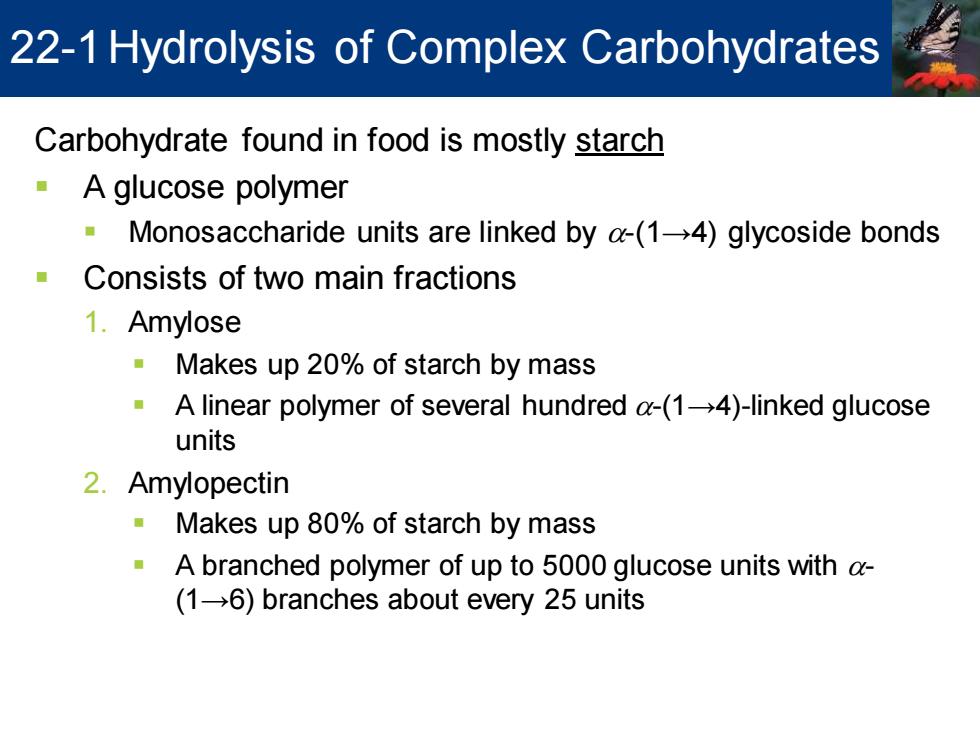
22-1 Hydrolysis of Complex Carbohydrates Carbohydrate found in food is mostly starch A glucose polymer Monosaccharide units are linked by a-(1-4)glycoside bonds Consists of two main fractions 1.Amylose Makes up 20%of starch by mass A linear polymer of several hundred a-(1-4)-linked glucose units 2.Amylopectin Makes up 80%of starch by mass A branched polymer of up to 5000 glucose units with a- (1-6)branches about every 25 units
Carbohydrate found in food is mostly starch ▪ A glucose polymer ▪ Monosaccharide units are linked by a-(1→4) glycoside bonds ▪ Consists of two main fractions 1. Amylose ▪ Makes up 20% of starch by mass ▪ A linear polymer of several hundred a-(1→4)-linked glucose units 2. Amylopectin ▪ Makes up 80% of starch by mass ▪ A branched polymer of up to 5000 glucose units with a- (1→6) branches about every 25 units 22-1Hydrolysis of Complex Carbohydrates
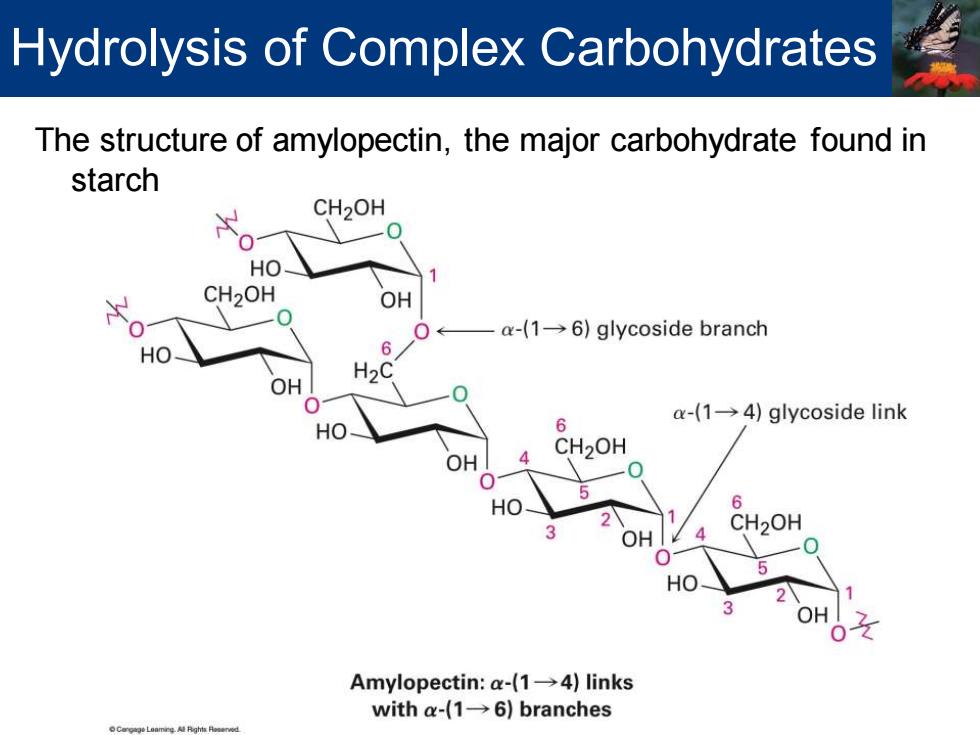
Hydrolysis of Complex Carbohydrates The structure of amylopectin,the major carbohydrate found in starch CH2OH HO- CH2OH OH 0← a-(1-6)glycoside branch HO 6 H2C OH a-(1-4)glycoside link HO 6 CH2OH 6 CH2OH HO Amylopectin:a-(1-4)links with a-(1-6)branches
The structure of amylopectin, the major carbohydrate found in starch Hydrolysis of Complex Carbohydrates

Hydrolysis of Complex Carbohydrates Digestion of starches Begins in the mouth Many of the internal(1-4)glycoside links are randomly hydrolyzed by a-amylase,a glycosidase Continues in the small intestines Gives a mixture of disaccharide maltose,trisaccharide maltotriose,and small oligosaccharides called limit dextrins, which contain (1-6)branches Final processing in the intestinal mucosa by additional glycosidases Yields glucose which is absorbed by the intestine and transported through the bloodstream
Digestion of starches ▪ Begins in the mouth ▪ Many of the internal (1→4) glycoside links are randomly hydrolyzed by a-amylase, a glycosidase ▪ Continues in the small intestines ▪ Gives a mixture of disaccharide maltose, trisaccharide maltotriose, and small oligosaccharides called limit dextrins, which contain (1→6) branches ▪ Final processing in the intestinal mucosa by additional glycosidases ▪ Yields glucose which is absorbed by the intestine and transported through the bloodstream Hydrolysis of Complex Carbohydrates
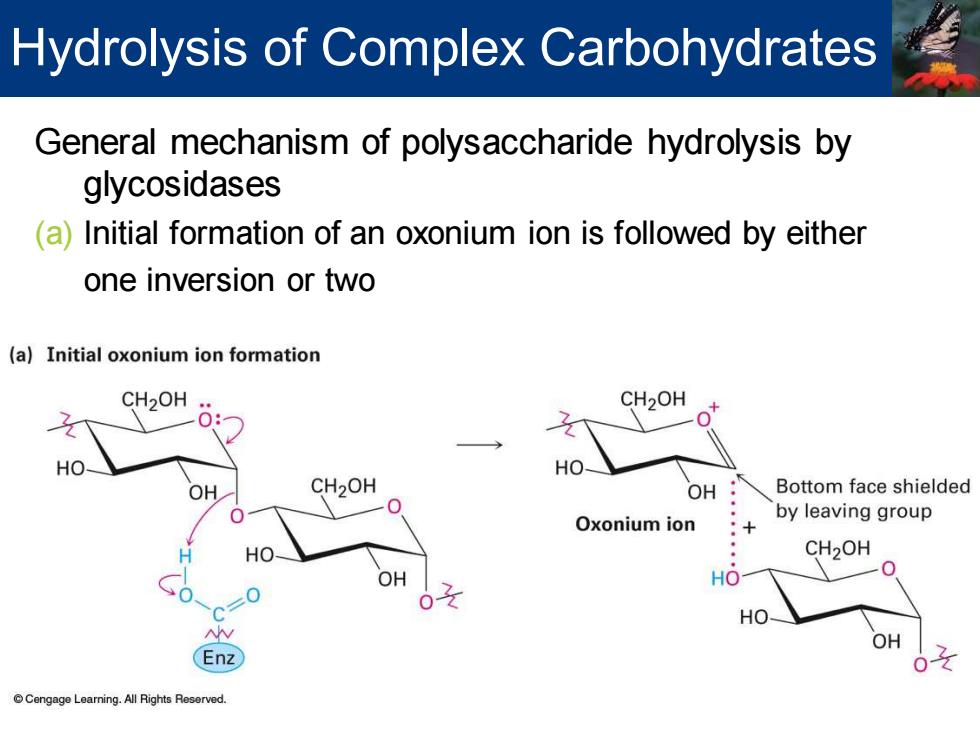
Hydrolysis of Complex Carbohydrates General mechanism of polysaccharide hydrolysis by glycosidases (a)Initial formation of an oxonium ion is followed by either one inversion or two (a)Initial oxonium ion formation CH2OH CH2OH OH CH2OH OH Bottom face shielded Oxonium ion by leaving group HO CH2OH OH HO 0之 HO Enz Cengage Learning.All Rights Reserved
General mechanism of polysaccharide hydrolysis by glycosidases (a) Initial formation of an oxonium ion is followed by either one inversion or two Hydrolysis of Complex Carbohydrates

Hydrolysis of Complex Carbohydrates (b)Inverting glycosidases operate through a single inversion by nucleophilic attack of water through an SN2-like inversion (b)Inverting glycosidase Enz CH2OH CH2OH HO HO OH OH OH Oxonium ion CH2OH HO -0 HO Cengage Learning.All Rights Reserved
(b) Inverting glycosidases operate through a single inversion by nucleophilic attack of water through an SN2-like inversion Hydrolysis of Complex Carbohydrates
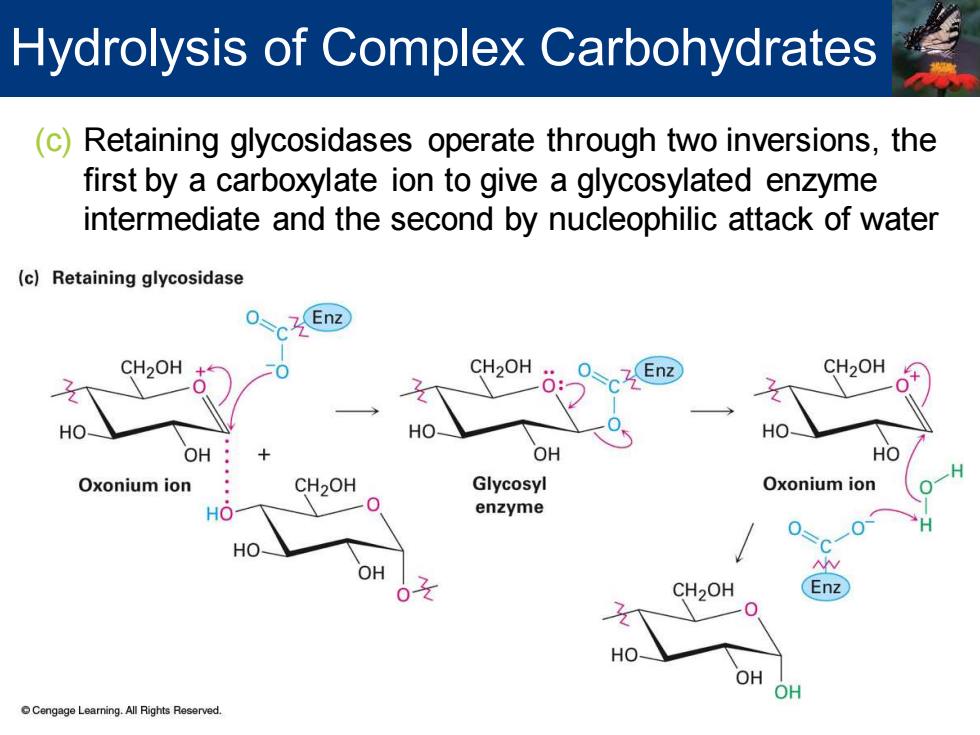
Hydrolysis of Complex Carbohydrates (c)Retaining glycosidases operate through two inversions,the first by a carboxylate ion to give a glycosylated enzyme intermediate and the second by nucleophilic attack of water (c)Retaining glycosidase CZ Enz CH2OH CH2OH Enz CH2OH HO HO HO OH OH HO Oxonium ion CH2OH Glycosyl Oxonium ion HO enzyme 0 HO OH 0 CH2OH Enz HO OH OH Cengage Learning.All Rights Reserved
(c) Retaining glycosidases operate through two inversions, the first by a carboxylate ion to give a glycosylated enzyme intermediate and the second by nucleophilic attack of water Hydrolysis of Complex Carbohydrates
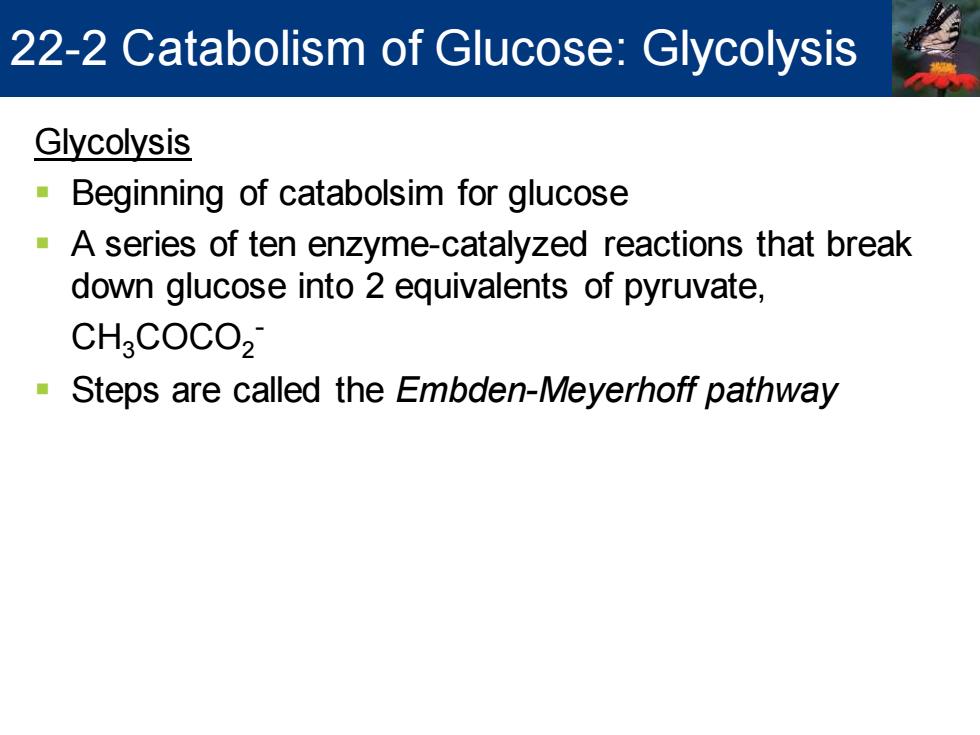
22-2 Catabolism of Glucose:Glycolysis Glycolysis Beginning of catabolsim for glucose -A series of ten enzyme-catalyzed reactions that break down glucose into 2 equivalents of pyruvate, CH.COCO2 Steps are called the Embden-Meyerhoff pathway
Glycolysis ▪ Beginning of catabolsim for glucose ▪ A series of ten enzyme-catalyzed reactions that break down glucose into 2 equivalents of pyruvate, CH3COCO2 - ▪ Steps are called the Embden-Meyerhoff pathway 22-2 Catabolism of Glucose: Glycolysis
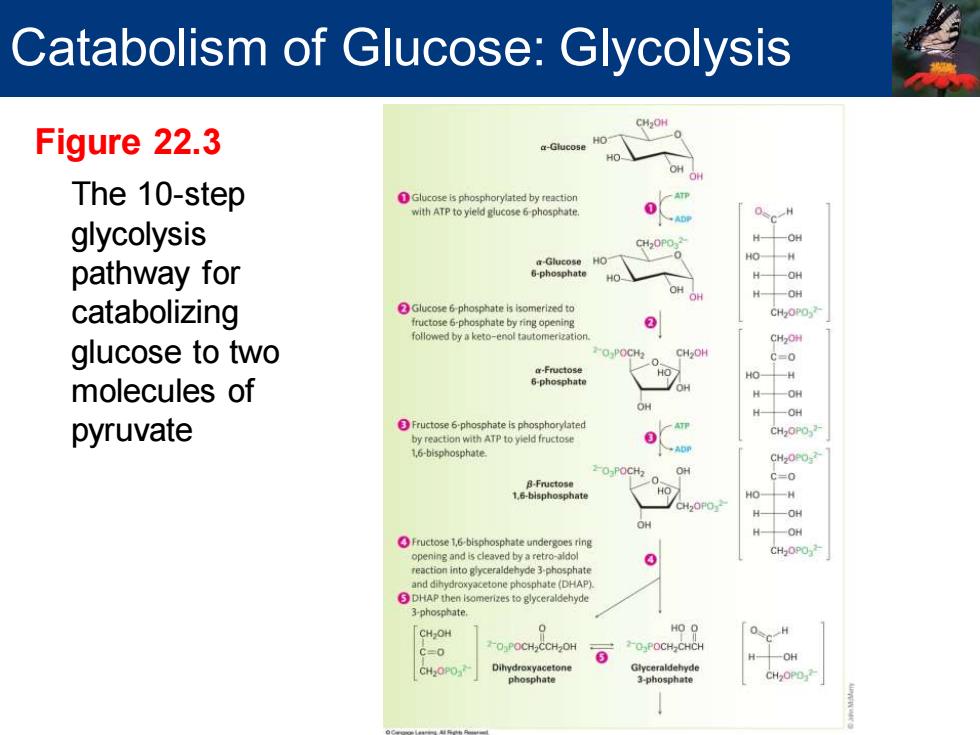
Catabolism of Glucose:Glycolysis CH2OH Figure 22.3 HO a-Glucose The 10-step Glucose is phosphorylated by reaction with ATP to yield glucose 6-phosphate. glycolysis hohte HO pathway for OH -0H catabolizing Glucose 6-phosphate is isomerized to fructose 6-phosphate by ring opening followed by a keto-enol tautomerization. glucose to two CH.OH C=0 molecules of OH -OH pyruvate Fructose 6-phosphate is phosphorylated by reaction with ATP toyield fructose 1.6-bisphosphate C=0 HO- -H H -OH Fructose 1,6-bisphosphate undergoes ring OH opening and is cleaved by a retro-aldol reaction into glyceraldehyde 3-phosphate and dihydroxyacetone phosphate(DHAP) 3-phosphate. CH.OH H00 c=0 O POCH CHCH 5 -OH
Figure 22.3 The 10-step glycolysis pathway for catabolizing glucose to two molecules of pyruvate Catabolism of Glucose: Glycolysis